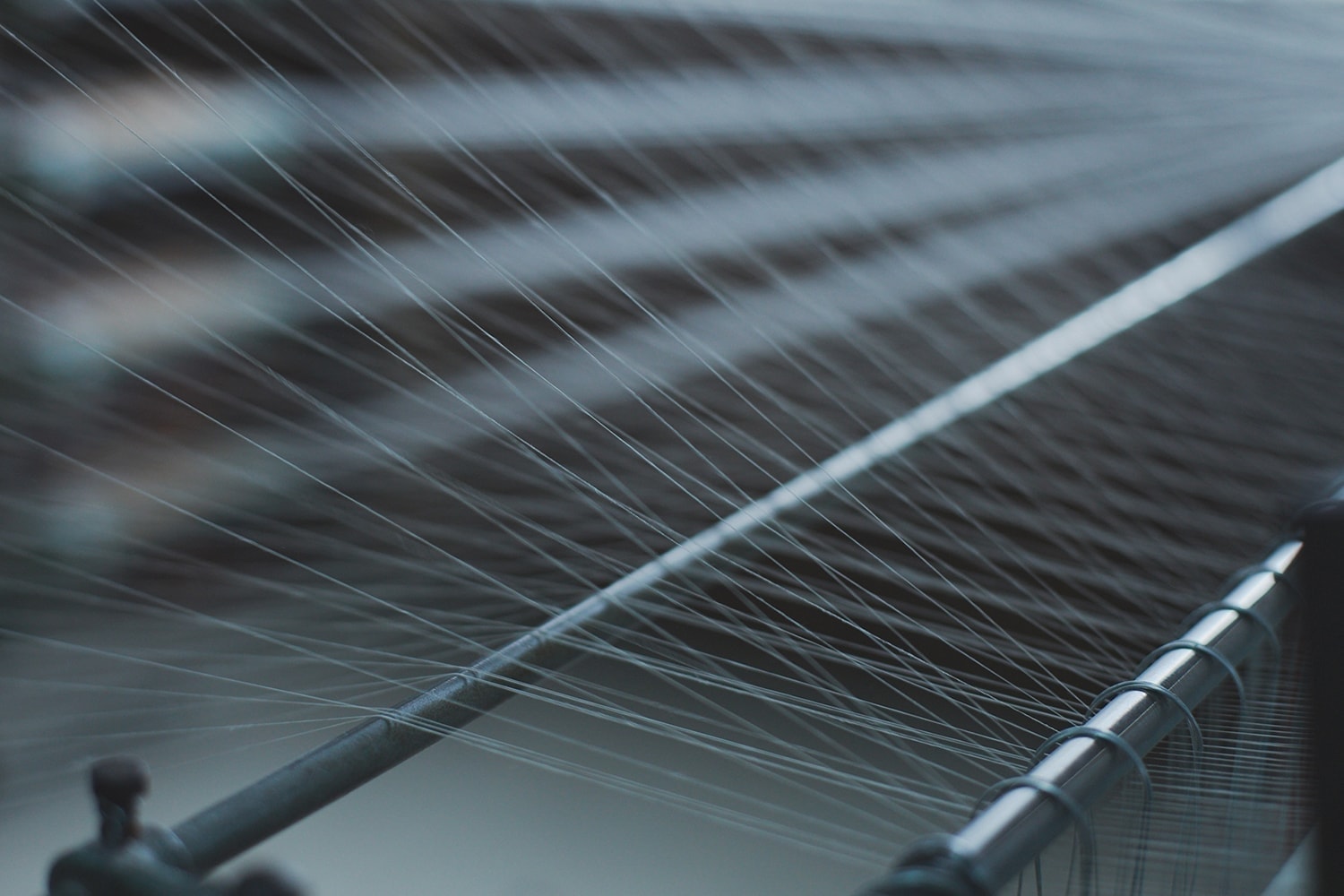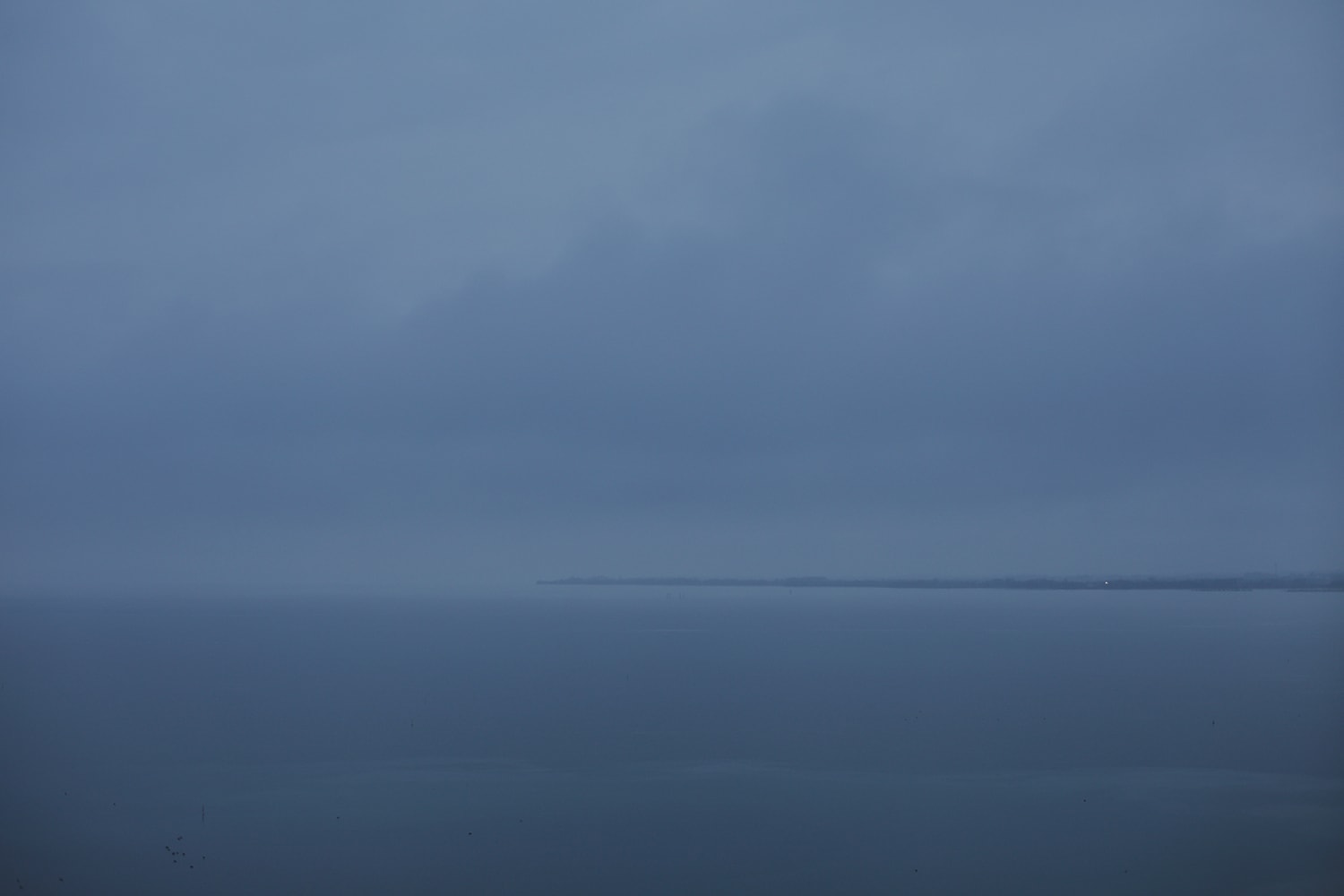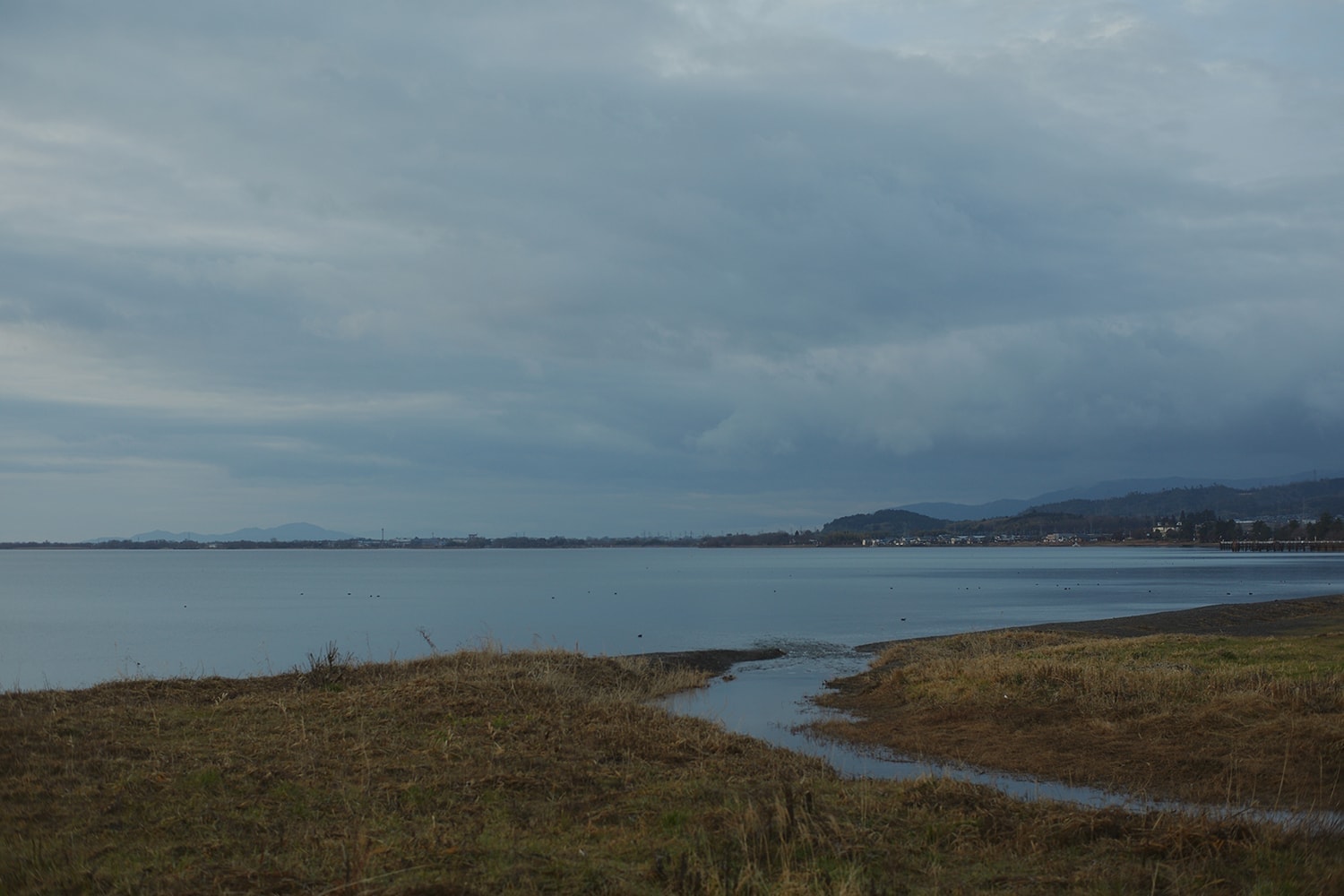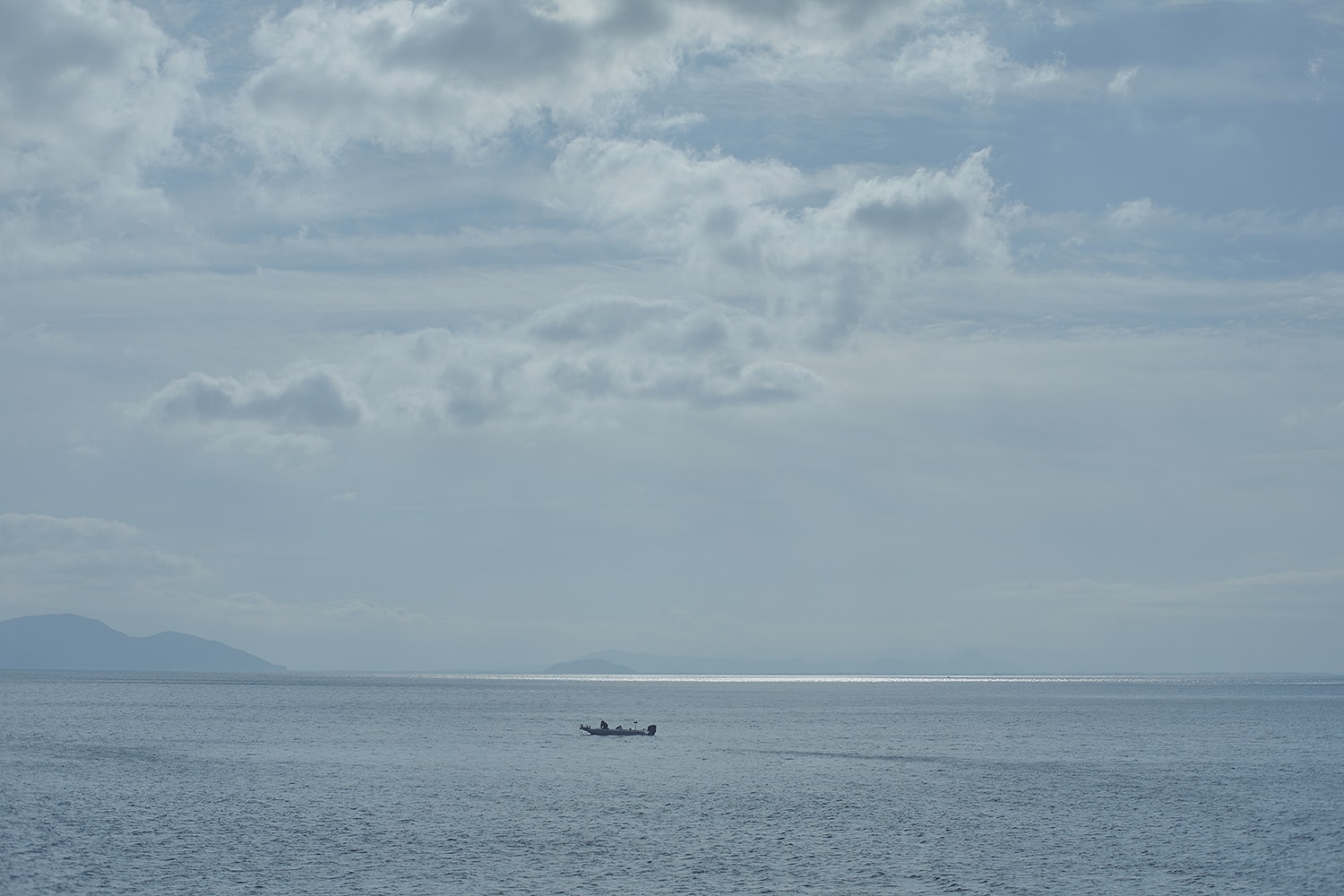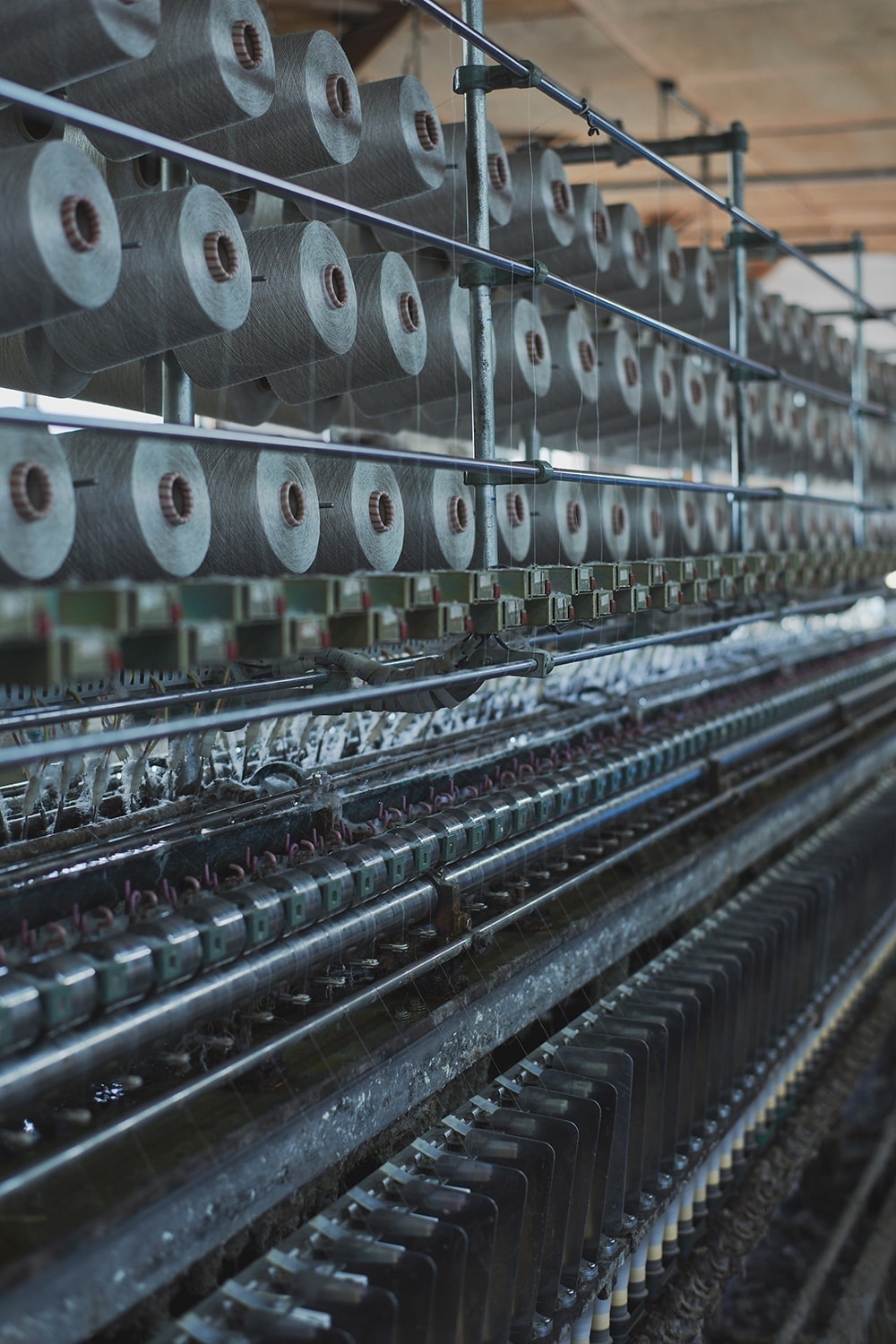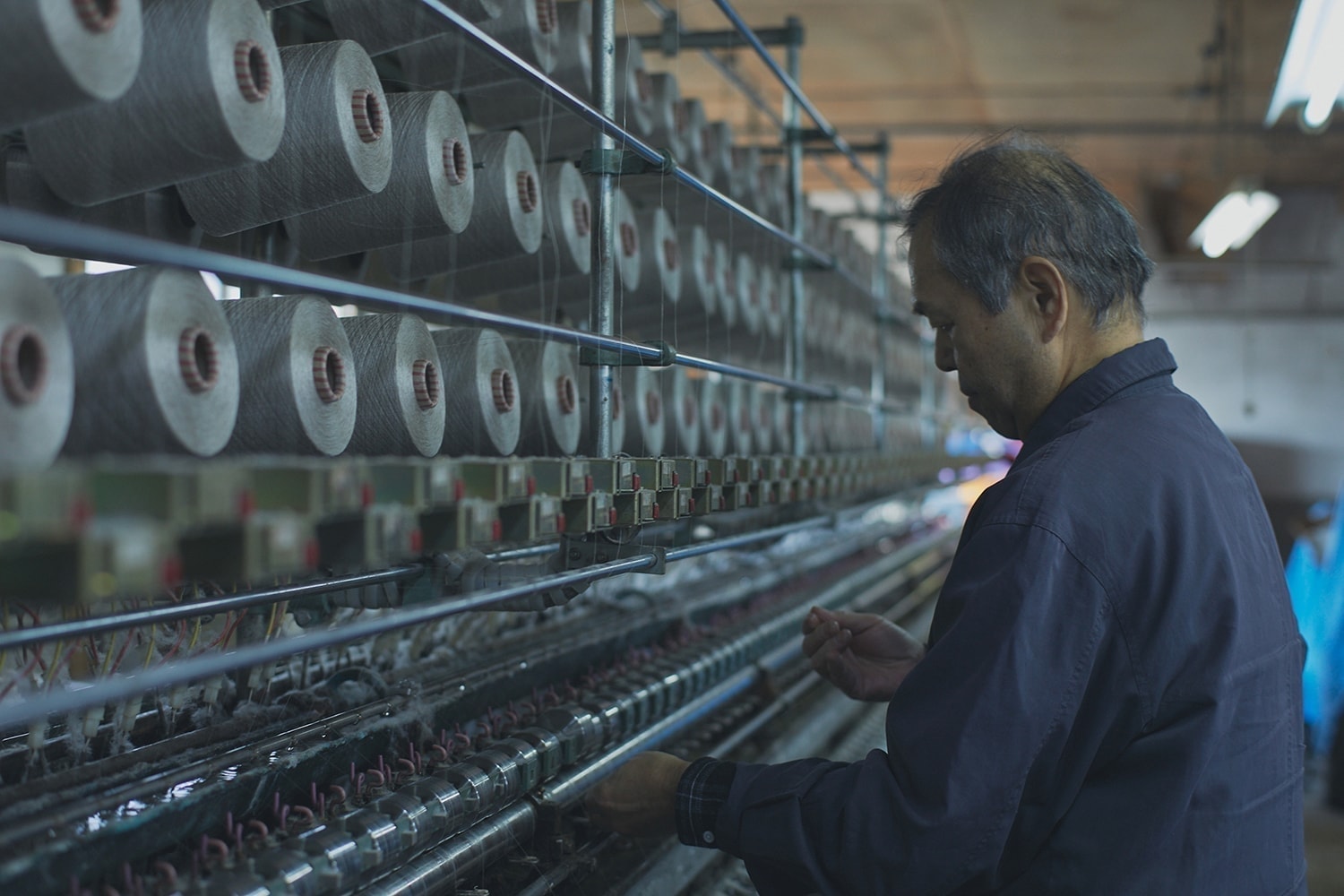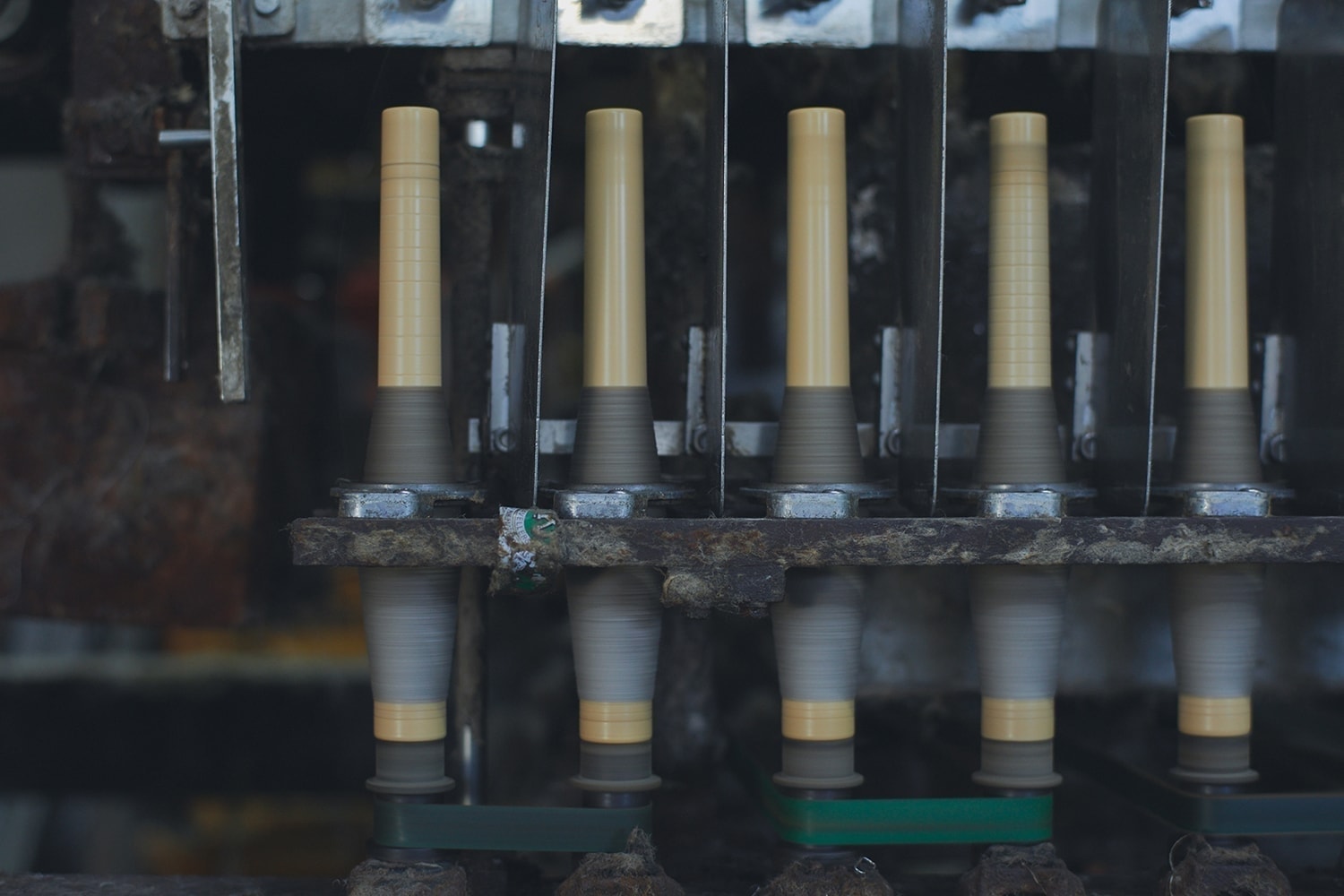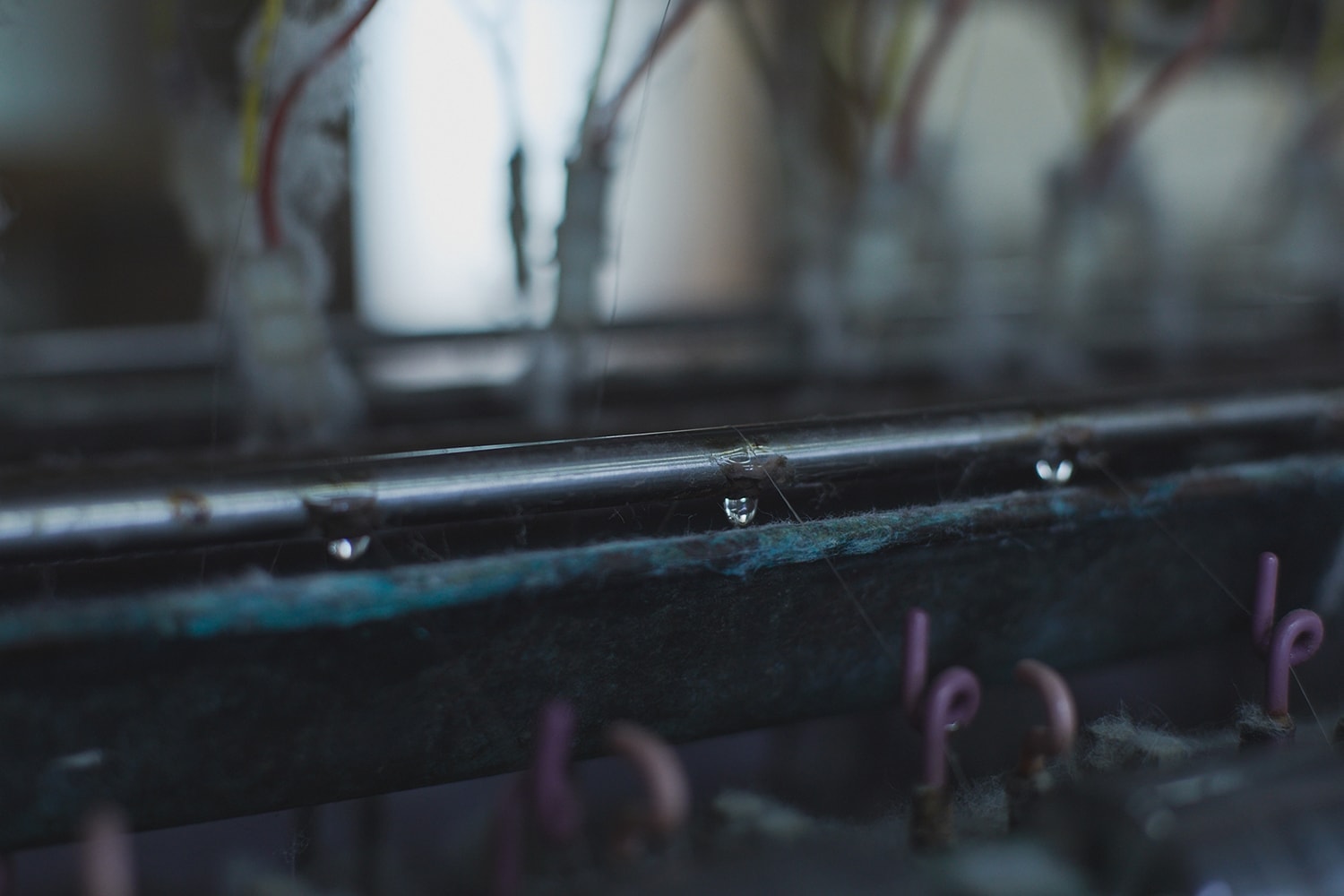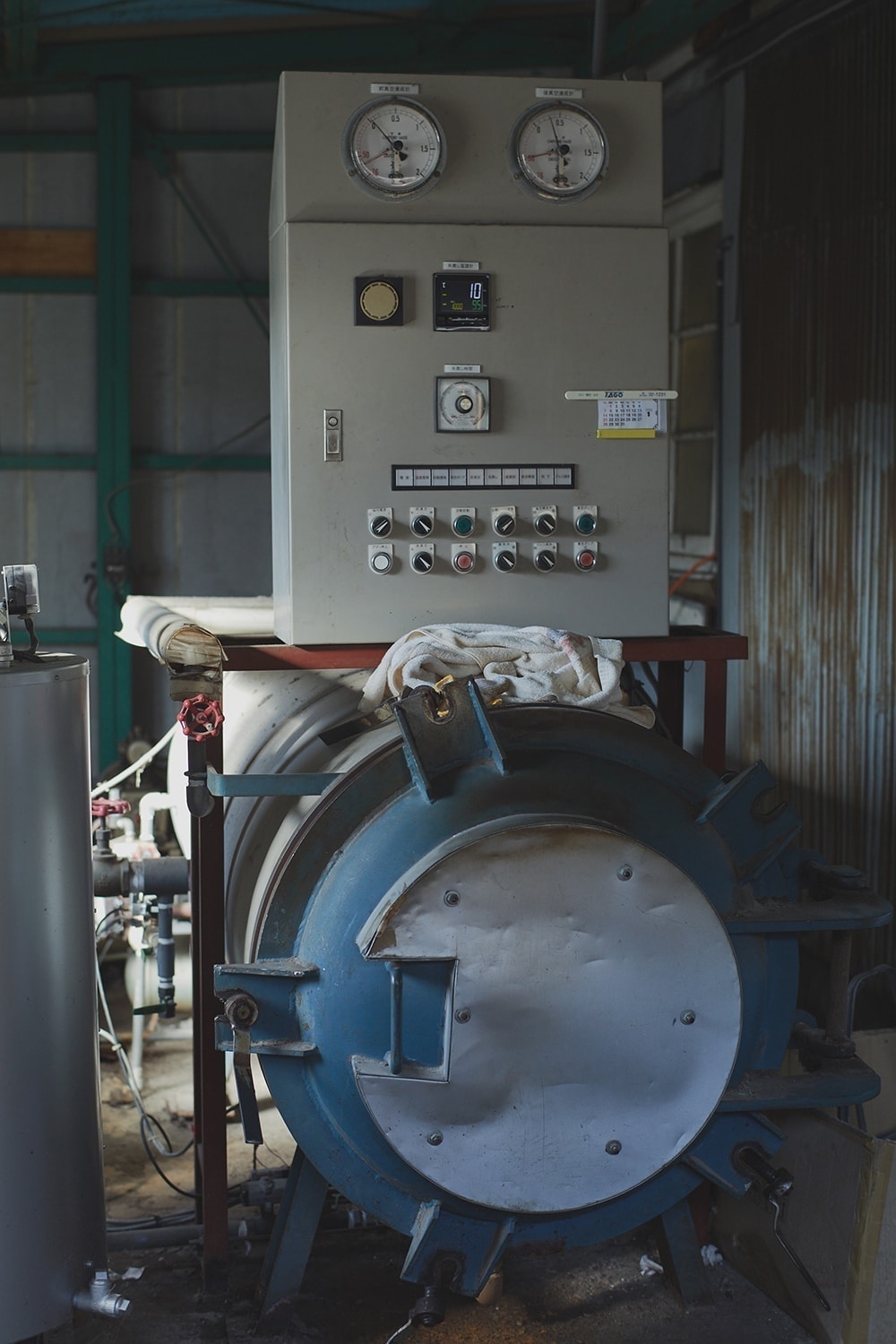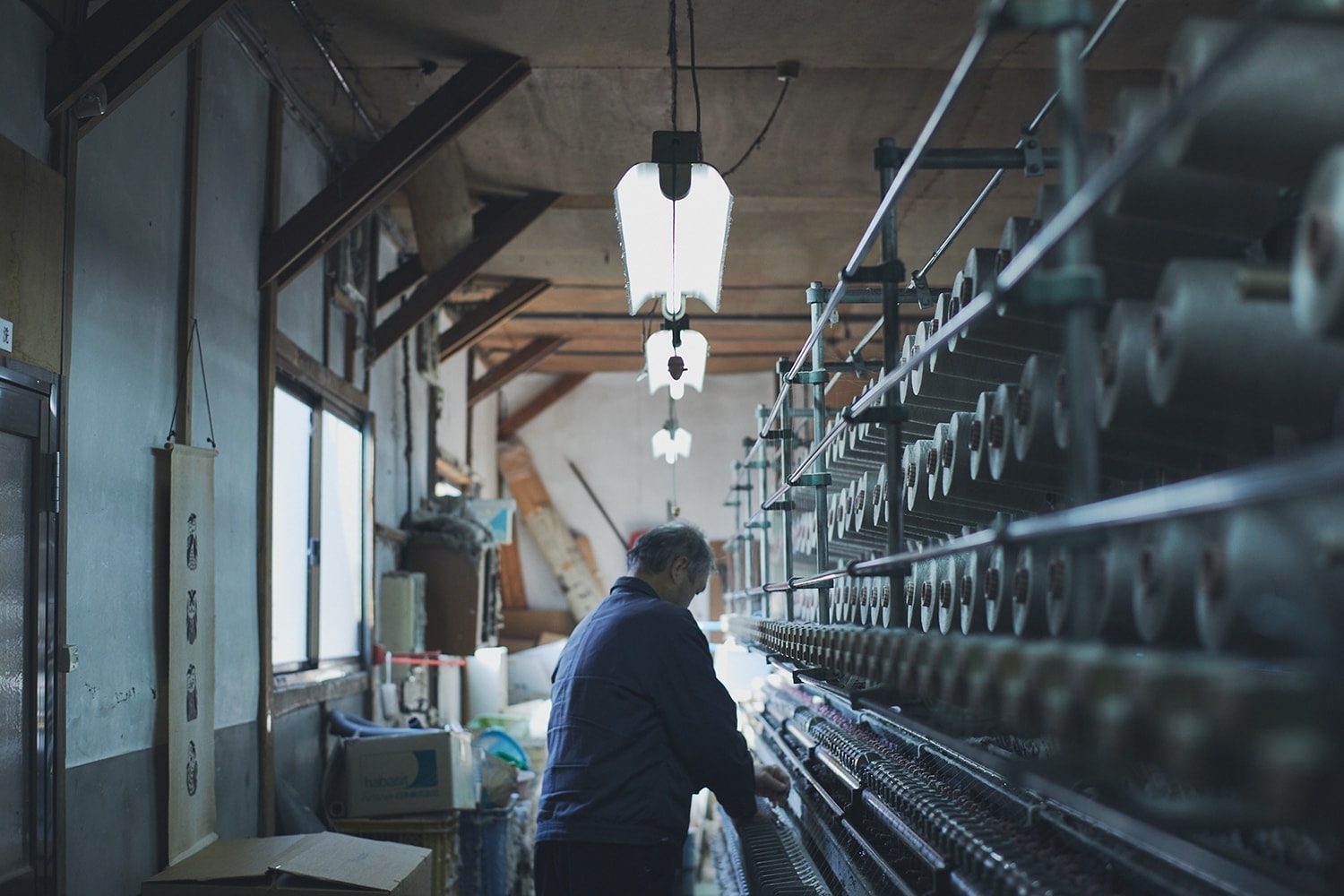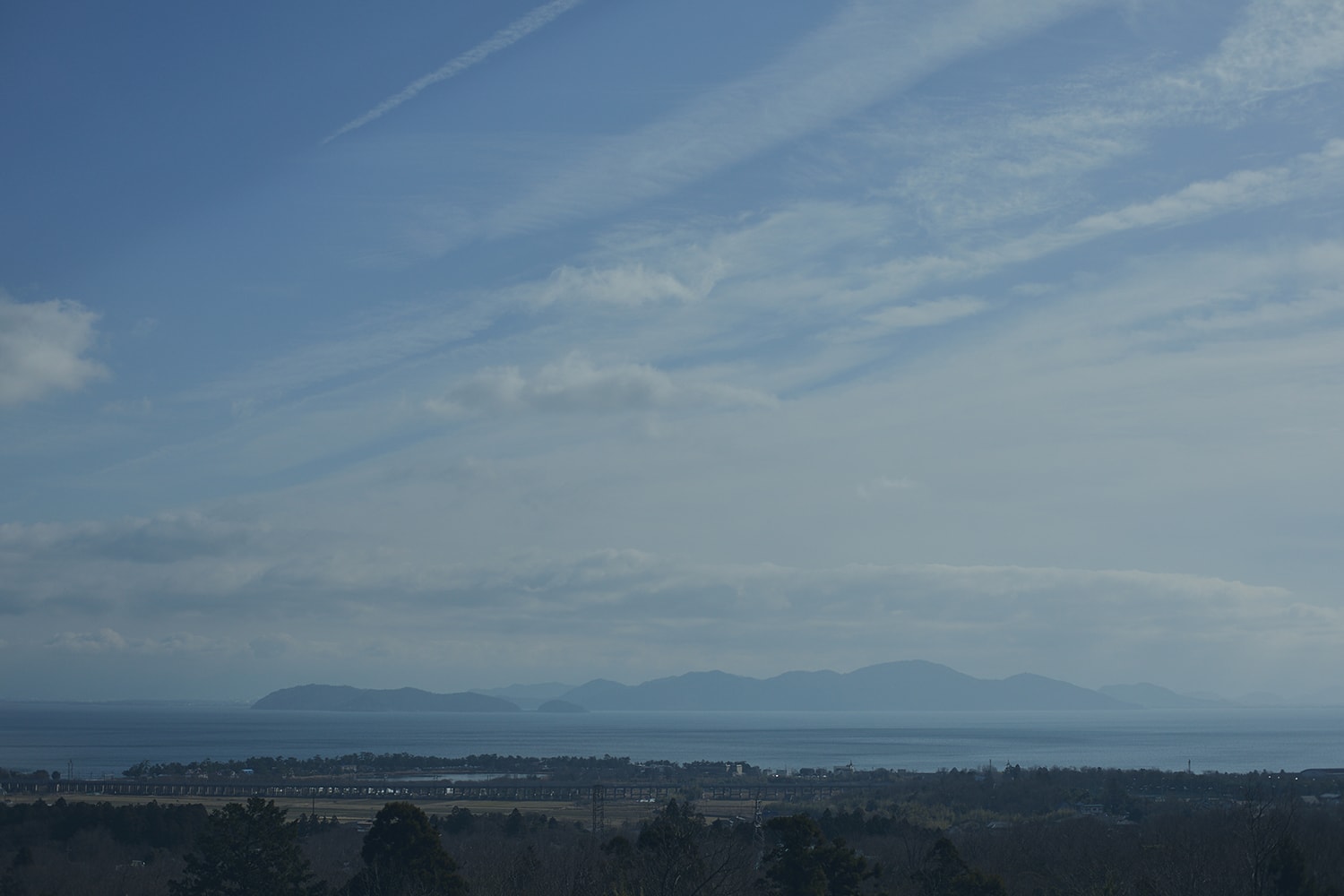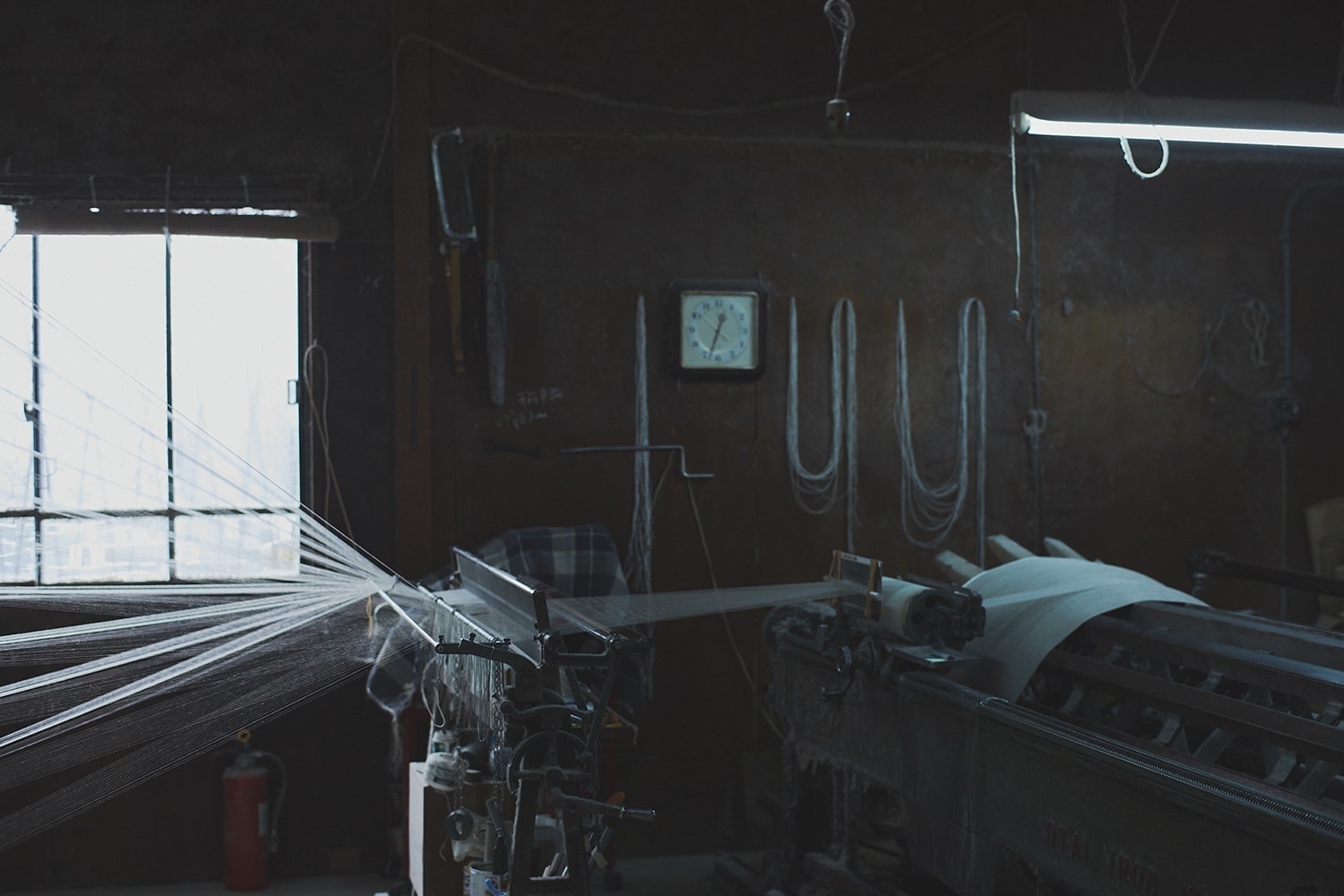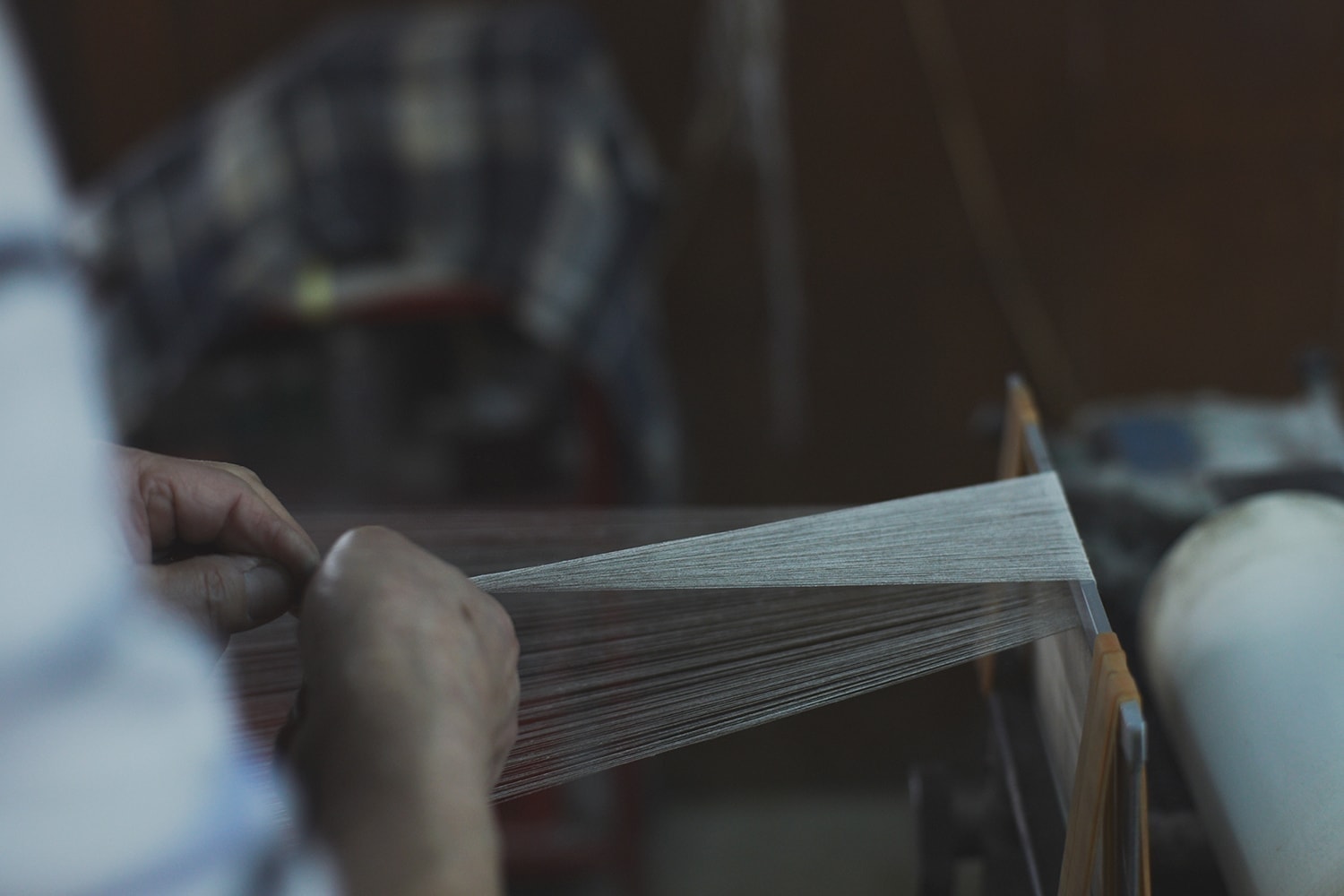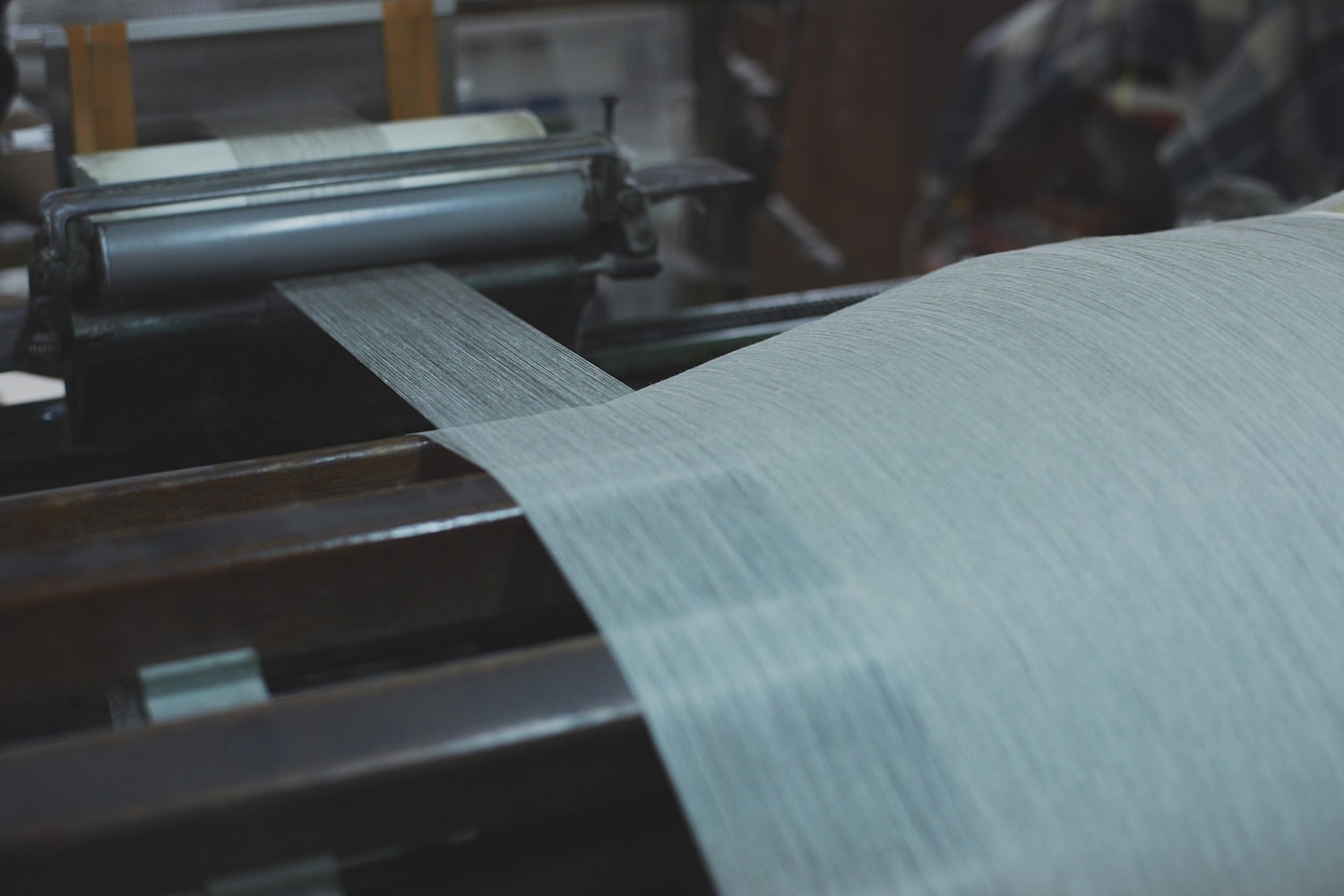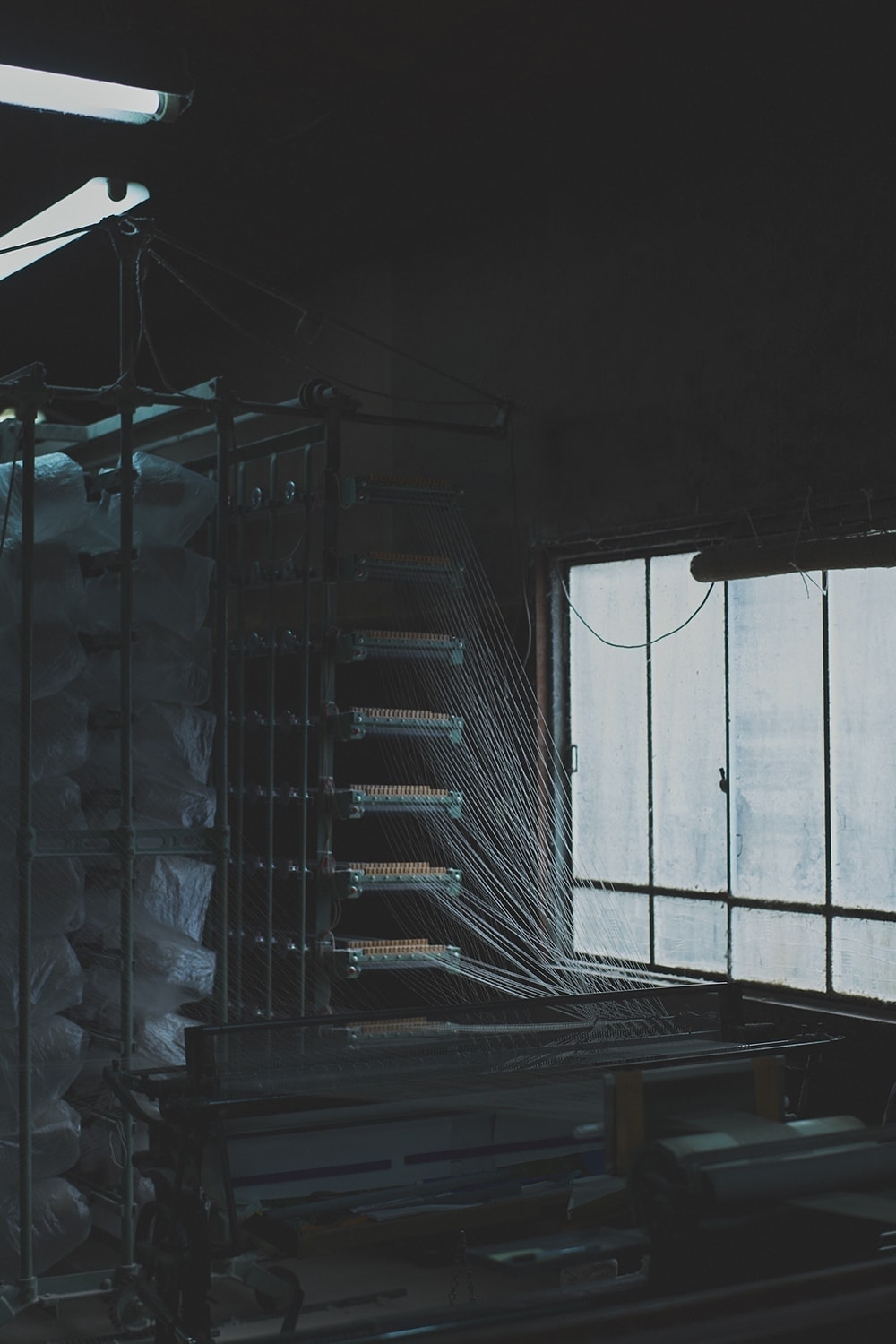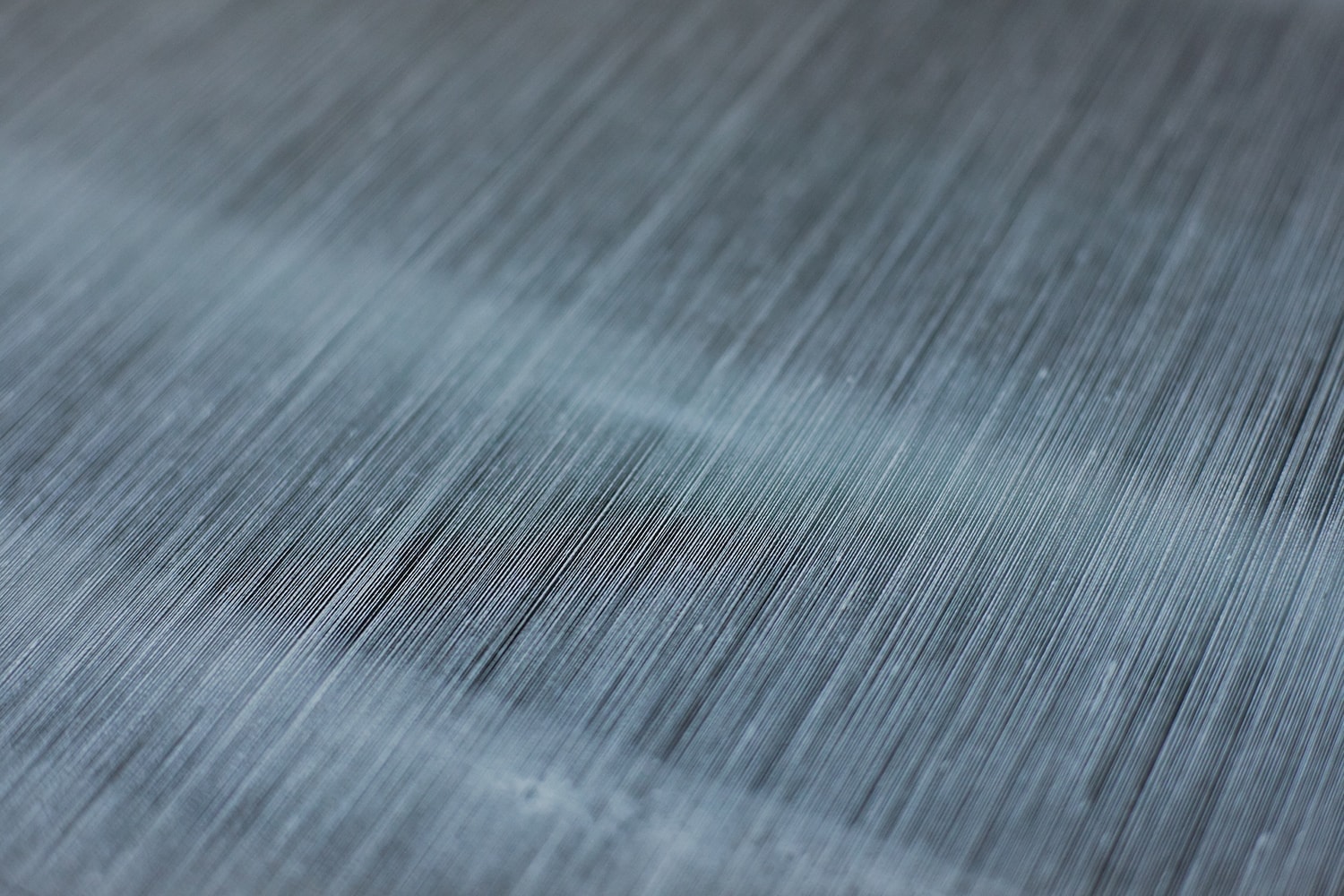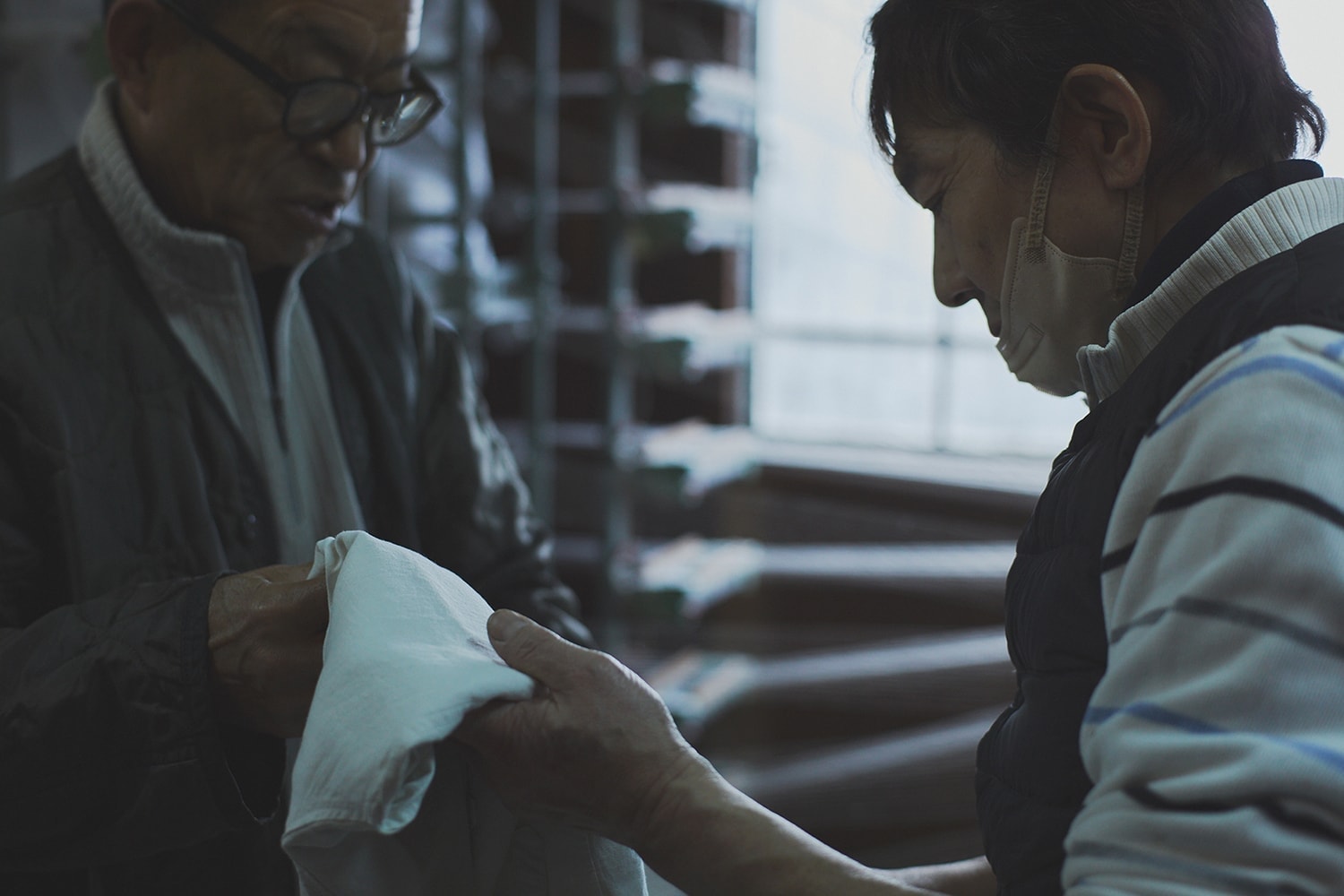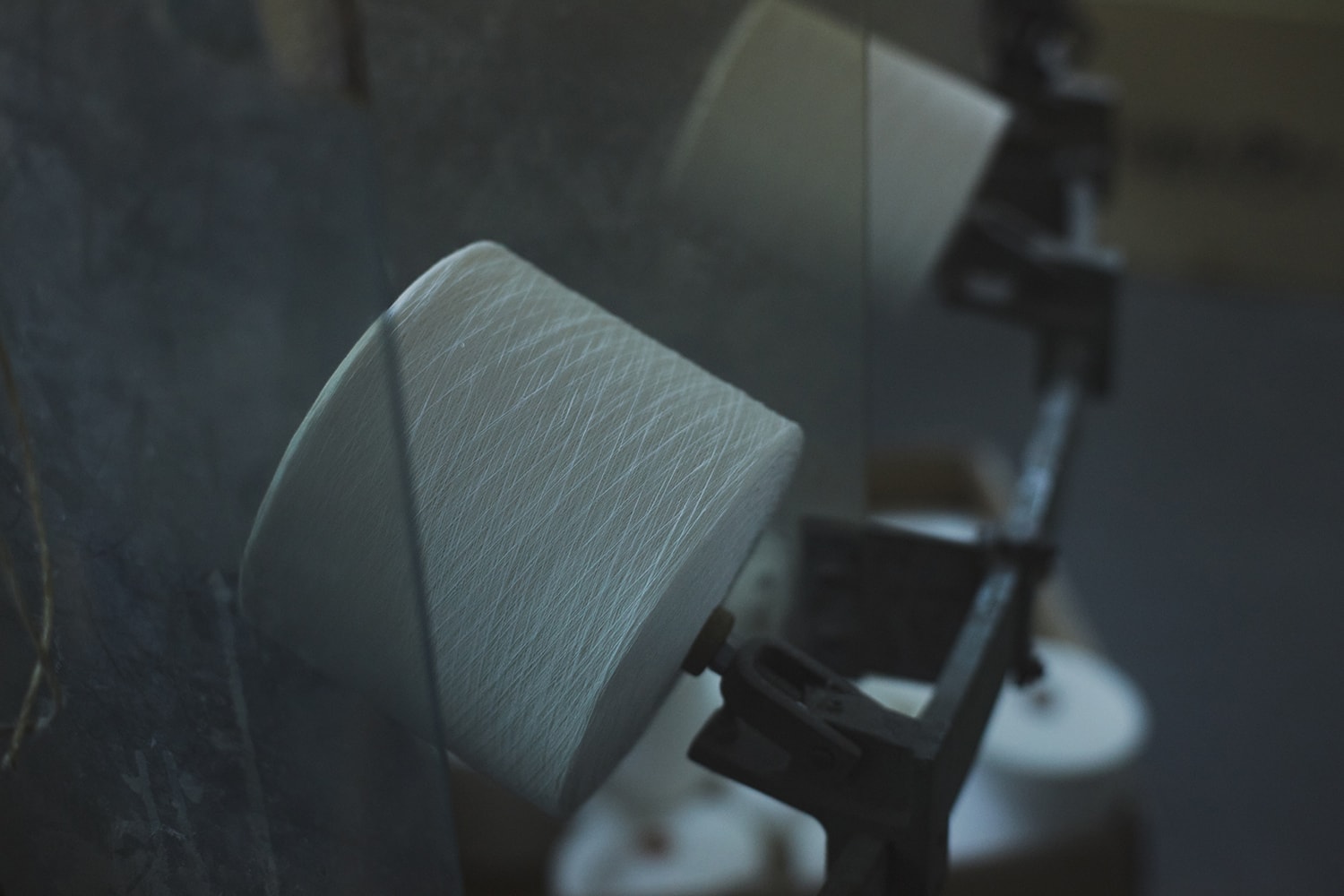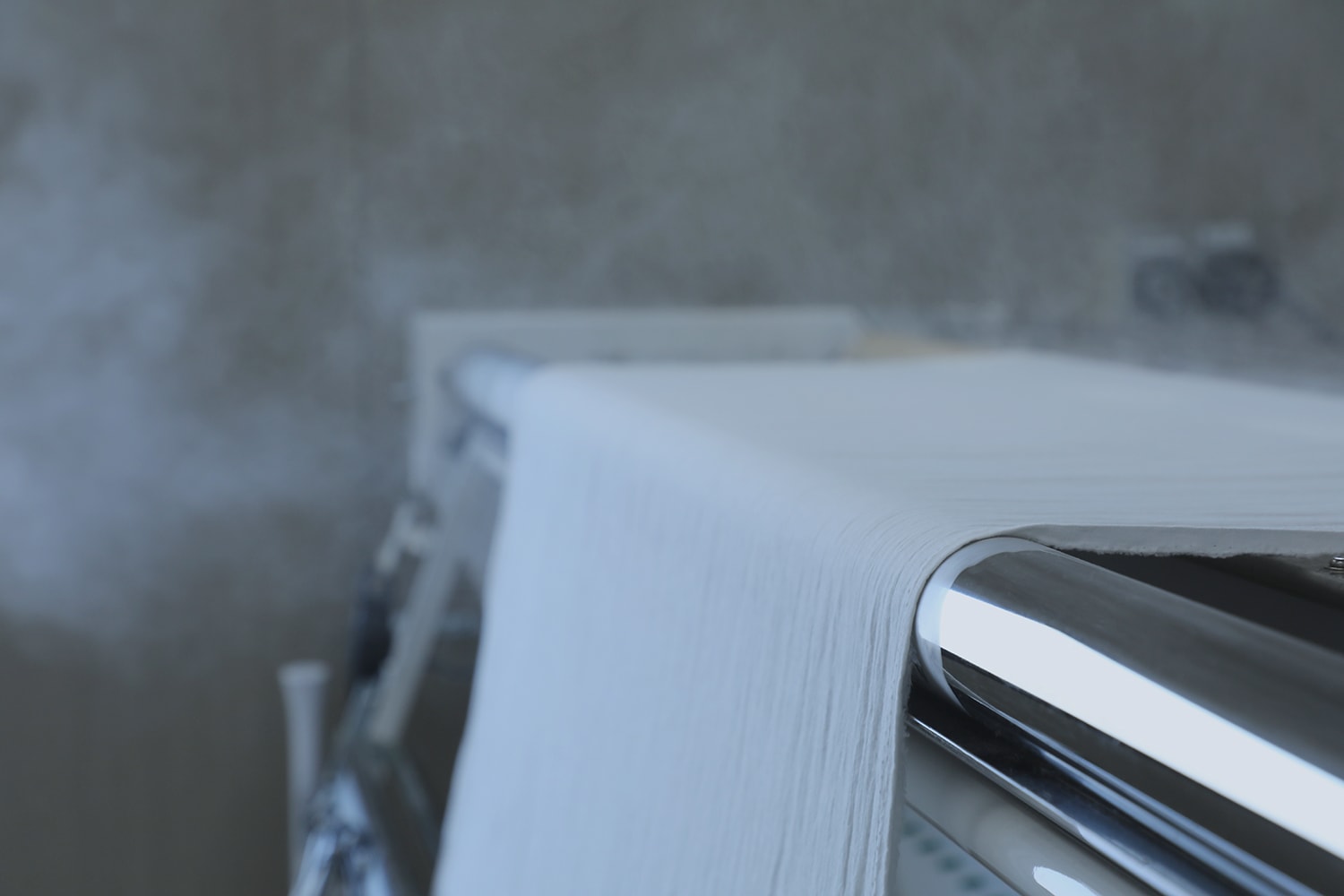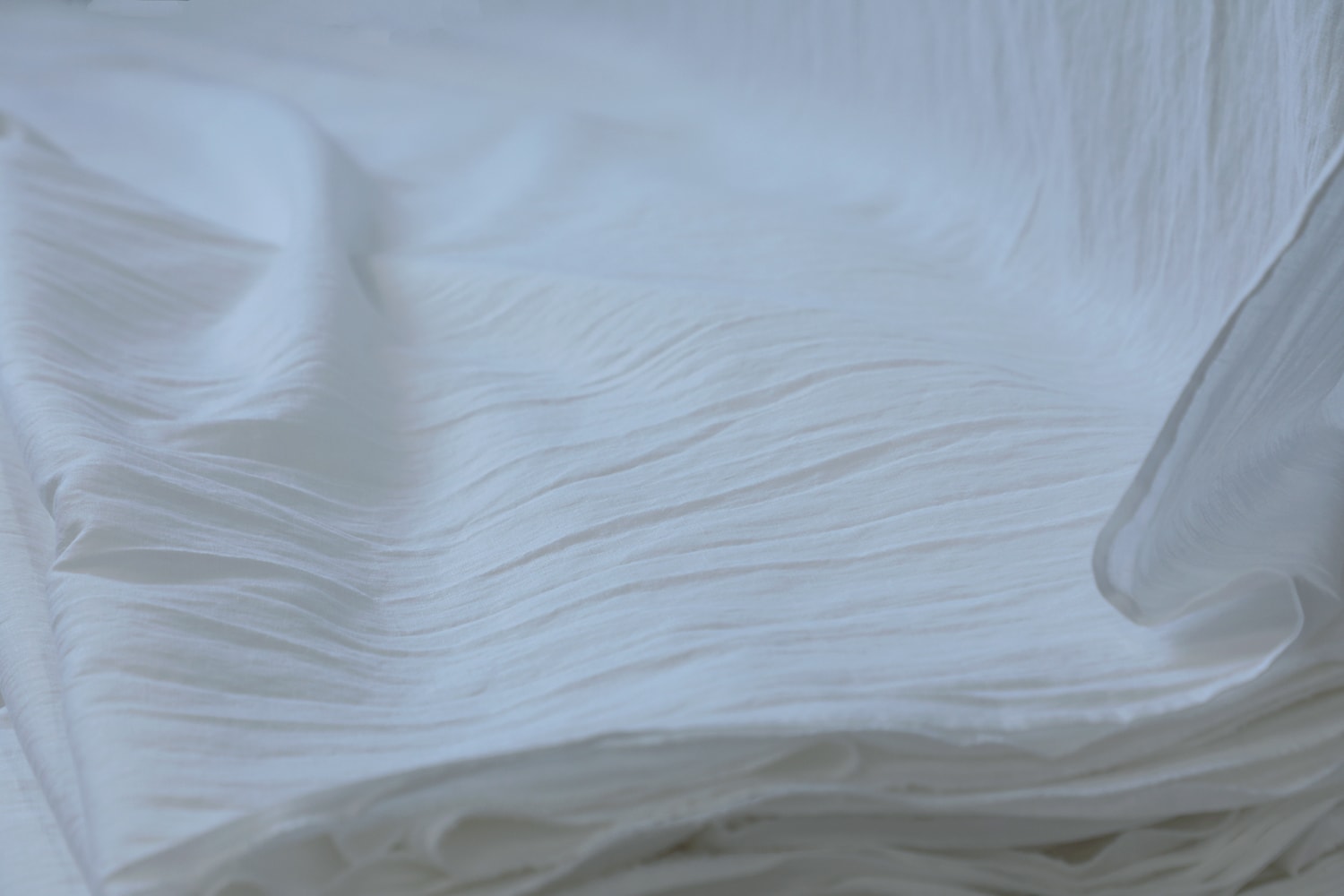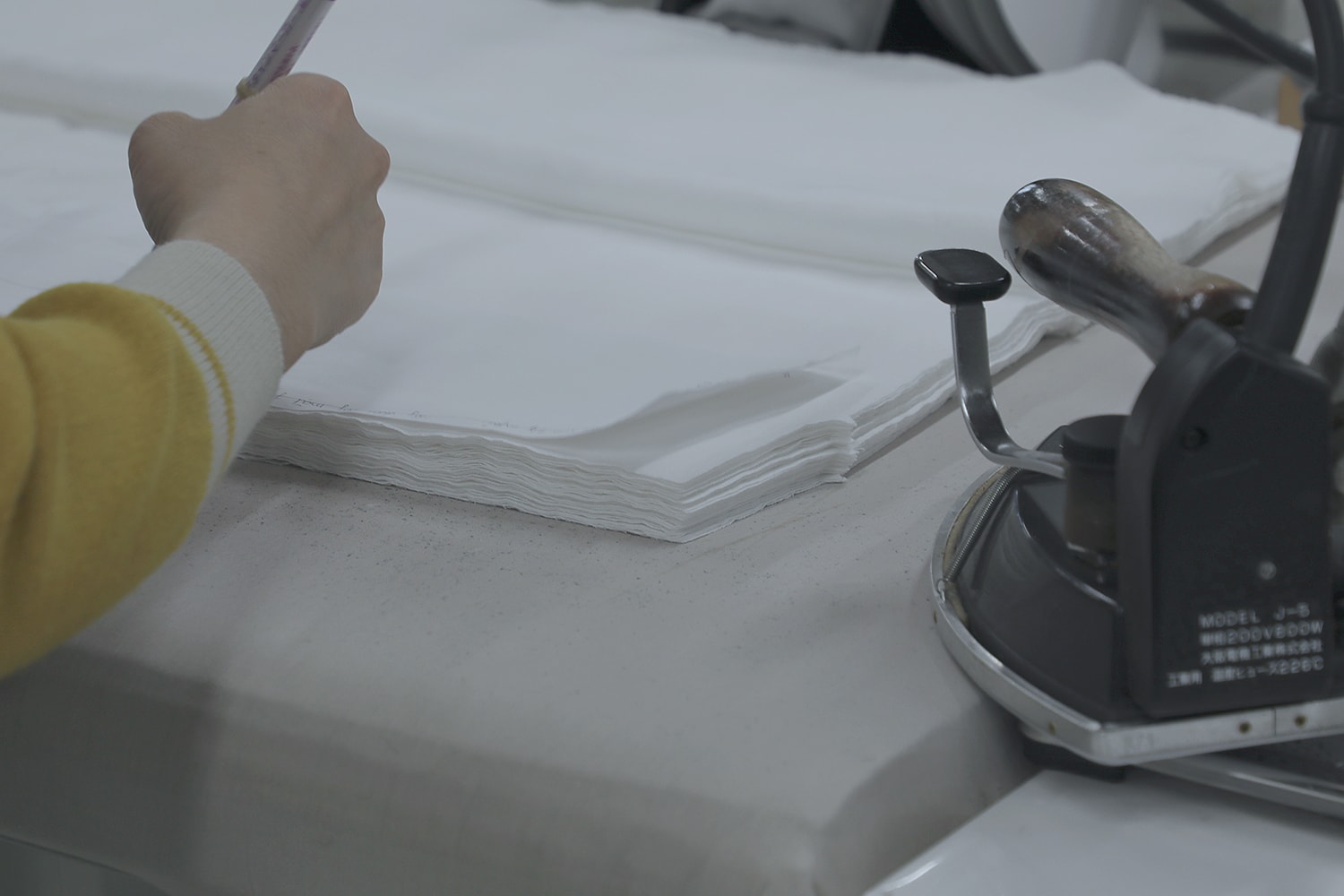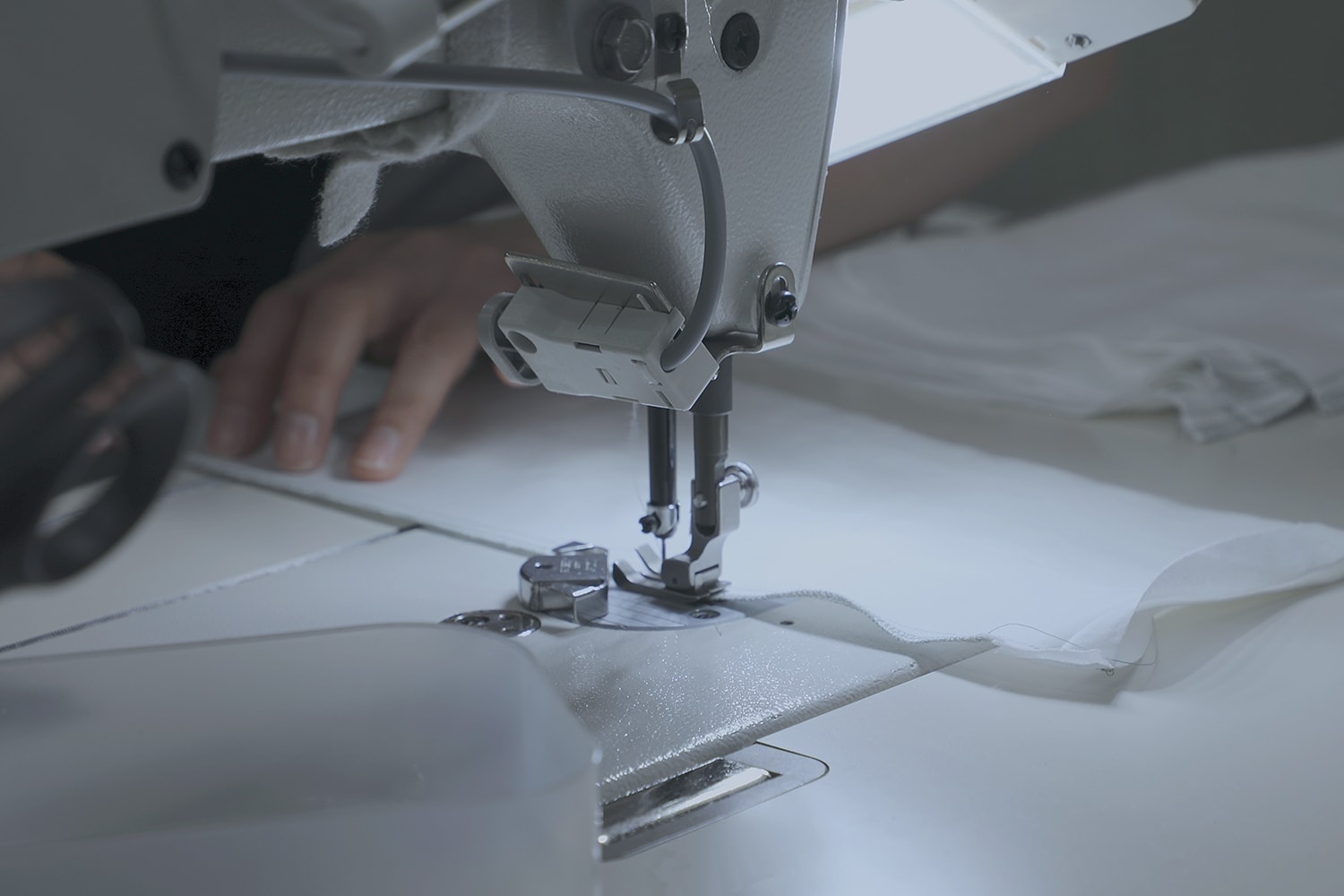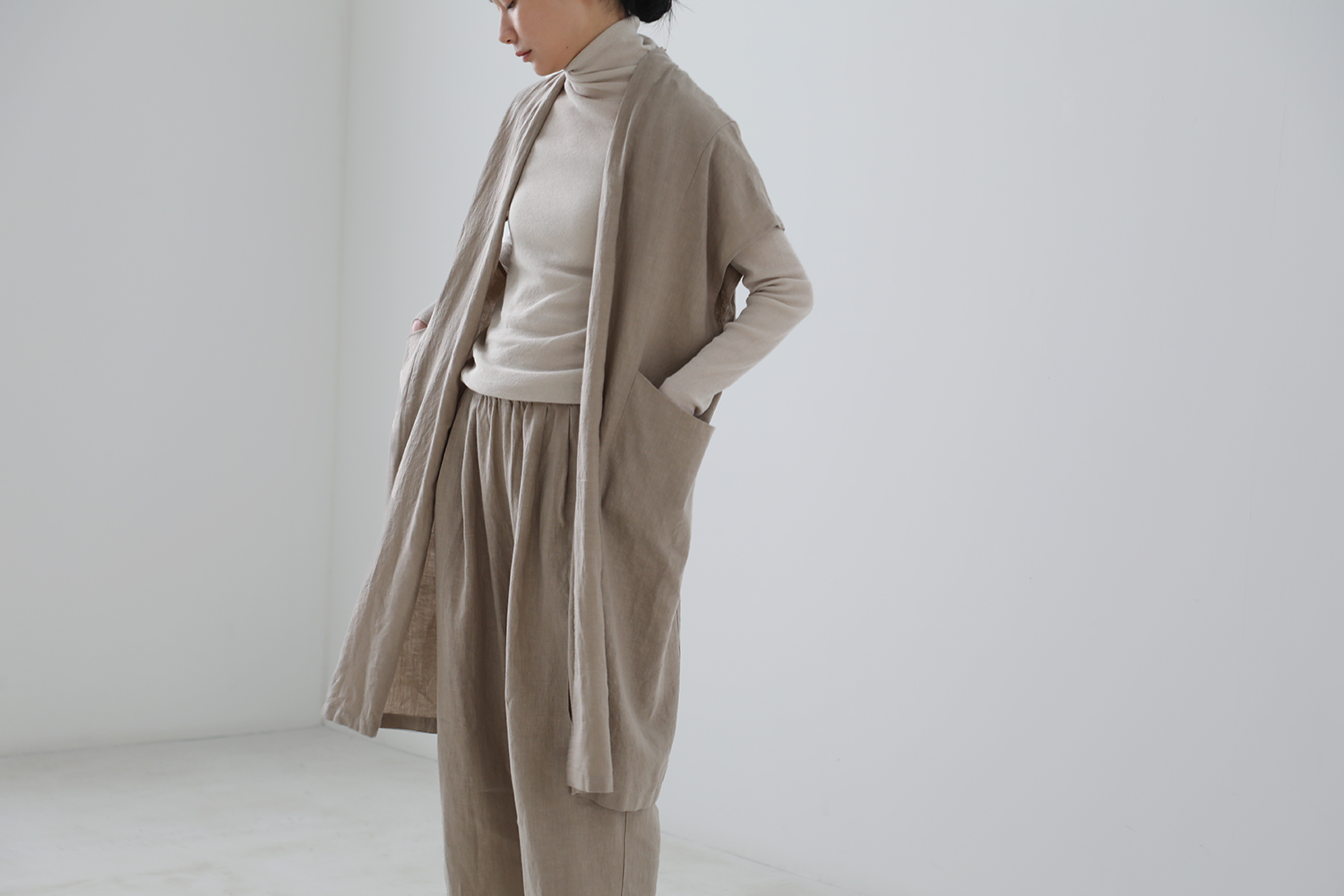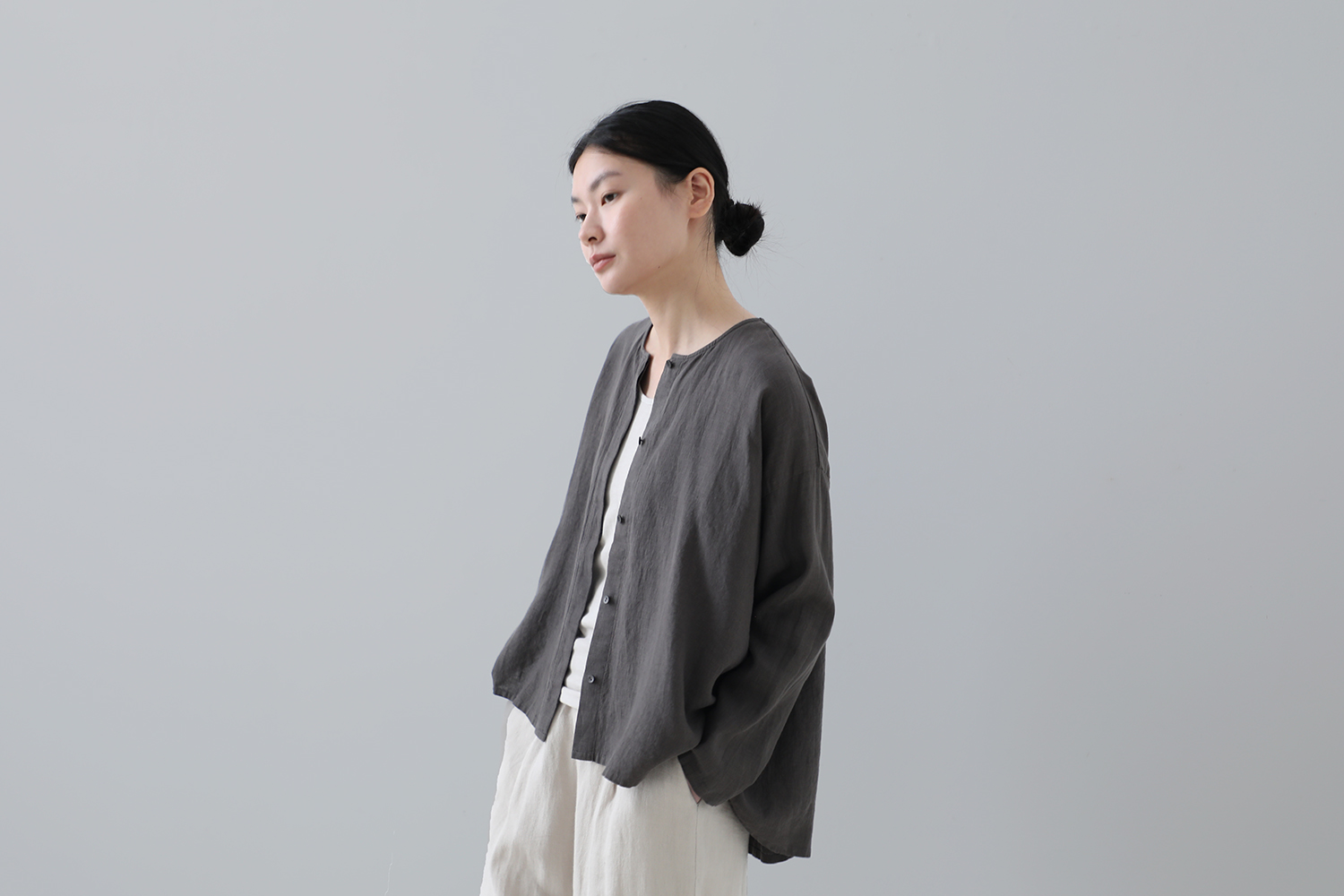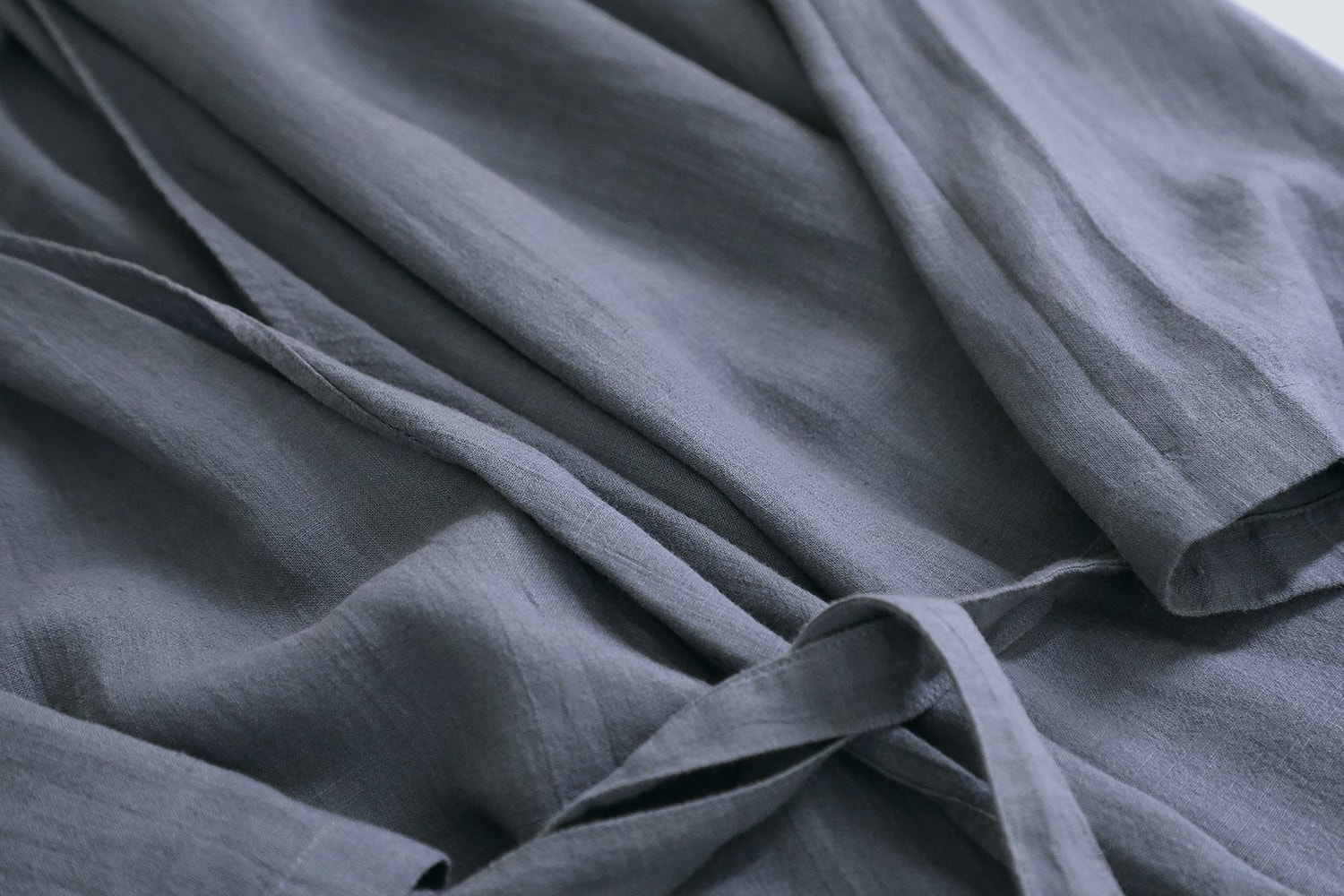2017年秋冬シーズンで登場してから、evam eva のコレクションに欠かすことのできない麻生地「water linen」。麻の一種であるリネンは季節を問わず、一年を通して着ることができ、身に纏うほどに豊かな風合いへと変わりゆくのが魅力です。今回は、水撚りという特殊な技法で撚られたリネンの糸から生まれる生地「water linen」のものづくりの背景をご紹介します。
洋服だけでなく、寝具やインテリアなど多くの用途で私たちの暮らしに寄り添うリネン。evam eva でもさまざまなアイテムでオールシーズン使用している素材です。リネンは夏の素材というイメージが強いですが、その繊維は中が空洞になっていて、空気を含むことができるため、汗ばむ夏日は水分を逃がし、さらりとした肌触りで涼やか、冬の寒い日には体温で温まった空気が体を包み込み、暖かく過ごすことができます。一年中着られるリネンだからこそ、着るほど、洗うほどにほぐれ、柔らかな表情に変化していきます。
リネン生地の中でも「water linen」は、一般的なリネンよりも繊維が傷みにくく、風合いが保たれ、着続けることでより味わい深くなるのが特徴。その「water linen」を織るための糸は、綿ちりめんの産地でもある滋賀県の北西部に位置している高島市でつくられています。
滋賀県は周囲を鈴鹿、伊吹、比良、比叡の山々に囲まれ、中央に県の面積の6分の1を占める日本で一番大きな湖「琵琶湖」をたたえています。琵琶湖には400を超える大小さまざまな河川が注いでおり、清らかな水を生み出す湧水地が存在しています。琵琶湖の豊かな水と湿潤な気候に育まれ、滋賀県の麻織物は長い歴史を刻んできました。
明治の初期に滋賀県長浜市で製造が始まった「浜ちりめん」。繭から繰りだされる生糸を2ヶ月以上かけて織物に仕立てていました。浜ちりめんの最大の特徴でもある美しいシボを生み出すために重要なのが、水撚りという撚糸技法。自然の恵みである雪解けの伏流水を用いて、他にはない独特の風合いの絹織物を大切につくり続けてきました。その技術を絹以外の天然繊維にも応用するために、試行錯誤を重ね、リネンの糸にも水撚り撚糸技法を施すようになったのが「water linen」のはじまり。
始めに伺ったのは湖西の今津町。ここから見る琵琶湖は小さな川がいくつも湖に注ぎ込み、静かに凪いだ水面に水鳥が羽を休め、釣り人が糸を垂れ、穏やかな景色が広がっていました。湖畔から少し入った静かな住宅街の一角に八坂撚糸工場は位置し、工場脇には清流が流れています。社長の八坂さんより撚糸の工程について説明いただきました。
原料となる麻の原糸に使用されているのは、主にフランス、ベルギー、オランダの3カ国の麻原料で、その年の気候や状態によって麻の品質が変わるため、色味や品位を見ながら、どの国のものを使用するか毎シーズン調整して選んでいます。
水撚りという撚糸技法は、繊維が紡がれている方向に沿わせながら1本ずつ糸を水の中にくぐらせて、濡れた状態で撚糸していく技法です。そうすることで毛羽となる繊維が撚り込まれ滑らかな糸に仕上がります。また、通常より強い力で撚りをかけることができるため、撚る回数を増やし、高回転で撚糸していきます。湿らせたリネンの糸はきゅっと締まり、より強度が増します。通常のリネン糸は太さにムラが出て切れやすいのですが、水撚りは毛羽が抑えられ、安定した綺麗な糸に仕上がります。
乾燥すると切れやすいリネンにとって、琵琶湖のもたらす湿潤な気候はとても適しています。濡れた状態で巻き取った糸は、一晩ほどかけてしっかりと乾燥させます。ゆっくりと水分をなくすことで、さらに強い糸となります。充分に乾いた糸を巻き取っていきますが、1日の生産量は10〜20kgほど。ゆっくりと人の手をかけて、「water linen」の糸はつくられます。
自然からもたらされる麻素材は、その年の天候や原糸の作り方によって色も性質も変わってきます。その性質を見極めながら機屋さんにとって織りやすい糸を届けることが撚糸屋さんにとって一番大切なことと八坂さんは言います。
撚糸技術はもちろん、糸を撚るときに水を使うため機械が錆びやすいことから、機械の手入れに関する技術も必要となるそうです。昔ながらの本来の工程で撚糸をする工場や機械のメンテナンスができる職人の方の数は、年々少なくなってきているのが現状。それでも、水撚り撚糸が今も存続できているのは、琵琶湖がもたらす恵みに寄り添い、長い歴史の中で育まれてきた水撚りという技法に誠実に向き合ってきた職人の方々の想いがあったからこそ。
本当によいと思えるものに触れる機会が失われていかないように、日本各地の技術やそれを支える人々の営み、文化を、まず私たち作り手が知り、次のものづくりに繋げていかなければいけないと感じました。
「water linen」を織っているのは、滋賀県東部の東近江市にある機屋の森野織物。四方を山々に囲まれ、東に広がる鈴鹿山脈からは清水が流れ出る。そんな高温多湿な環境が麻の製織、染色、仕上加工に適してたことから、このあたりでは古くから「近江麻」と呼ばれる麻織物がつくられてきました。脈々と受け継がれてきた近江麻の伝統ある製法によって、「water linen」の生地は生まれます。
湖西から湖東にある森野織物へは琵琶湖大橋を渡って車で1時間半、琵琶湖の大きさと水際の見せる表情の違いを眺めながら向かいます。
通常のリネン生地を織る工程と異なるのは、生地を織る前に行う「経通し」という経糸を通す作業を機屋さん自身がされていること。「water linen」は、一般的なリネンよりも経糸の本数が多く、3000本以上の経糸を織機に張っていきます。そのため緯糸の打ち込みも多くなり、一日に織り上がるのはたったの数十メートル。また織りは撚られた糸の状態や気候の影響をとても受けやすく、機械にかけて織り始めてから糸が切れてしまうこともあり、そのときは機械をとめて調整を繰り返します。それでも上手くいかない時は機械を変えてみたり。まるで機嫌を伺うように音と静寂の時間を重ねています。
八坂さんや糸加工業者の方々と対話を重ね、工夫しながらゆっくりと織り進め、そうして織り上がった生地は、リネン本来の自然な艶感と不均一に現れる糸の節が揺らぎのある豊かな表情をつくります。目で見て、手で触れる感覚に意識を向けて、じっくりと見極めながらつくられている現場を拝見し、森野さんの妥協しないものづくりへの姿勢に、畏敬の念を感じました。
江戸時代に近江を本拠地として日本中を行商した近江商人の ‘売り手よし、買い手よし、世間よし‘ という三方よしの理念が脈々とその地に受け継がれ、さまざまな人が関わり合ってものづくりが成り立っていることが窺えました。
ある取引先の方から「八坂さんは技術じゃなくて根気だね」と言われたと何気なく話されたこと。森野さんも「その時々で織りが上手くいかないことをどうこう言っても始まらない。機械にかけて調整を繰り返すだけ」とお二人の共通した仕事への向き合い方を笑いながらお話ししてくださったことがとても印象的でした。その根気を粛々と重ねた先に得られた技術。対岸で仕事をするお二人と、それを繋ぐ大前さん。この地に根付くものづくりと、それを相手にとって良いかたちにして手渡すというそれぞれの仕事のあり方に、歴史の中で育まれた文化を感じました。
撚糸、織り、それぞれに込められた沢山の方々の想いを受け取り、丁寧に服に仕上げていきます。
届いた反物は、巻き取る際に生地にかかったテンションや歪みを整えるために、適度な湿度と温度を与え、1日放反しておきます。生地を平らに解放することでリラックスした自然な状態に戻します。それと同時に人の目で隈なく検反を行います。生地のことをきちんと知ることで、この後の裁断、縫製作業へと円滑に繋がっていきます。
人が纏ったときに美しくみえる形と着心地を考慮し、パターンを作成。生地を無駄にしないようにパーツを裁断し、素材の状態に合わせて微調整しながら縫製していきます。製品に仕上げてから染めているため、リネンに色が自然と重なり、より柔らかな色合いに。
2024 autumn winter water linen collection
E243T031 pants beige
流れたゆたう水に委ね、撚られた糸。歴史と風土に育まれた伝統ある技術で織られた生地。滋賀に息づくものづくりを守り、つくり続けてこられた職人の方々の想いによって、美しく上質なものが今なお残り、私たちの暮らしを豊かにしてくれています。これから先、何十年と、この「water linen」が存在していることを深く願いながら、evam eva では洋服を仕立て続けるとともに、ものづくりの背景を一つひとつ丁寧に拾い上げ、言葉を紡いでゆくことで、ものに宿る人々の想いに触れる機会になれば幸いです。
7年ほどの時を過ごした「water linen」。月日を重ねることで生まれる生地のあたりや馴染みゆく色合い、質感。愛用していた日々を物語るようにたたずむ姿に、より愛着が深まります。これから新たに「water linen」を迎える皆さまへ。永い歳月を共に過ごしてもらえたら嬉しく思います。
photographer:小室野乃華
column|water linen
Since its introduction in the 2017 Fall/Winter season, “water linen” has been an essential part of evam eva’s collection. Linen, a type of hemp, can be worn throughout the year, regardless of the season, and the more you wear it, the richer its texture becomes. In this issue, we will introduce the background of manufacturing “water linen,” a fabric produced from linen yarns twisted by a special technique called water twisting.
Linen is a material used not only for clothing, but also for bedding, interior design, and many other purposes in our daily lives, and it is a material that evam eva also uses for a variety of items in all seasons. Among linen fabrics, “water linen” is characterized by the fact that its fibers are less prone to damage than ordinary linen, and its texture is preserved and becomes more palatable as it is worn over and over. The threads used to weave “water linen” are made in Takashima City, located in the northwestern part of Shiga Prefecture, which is also the production center of cotton crape.
Shiga Prefecture is surrounded by the mountains of Suzuka, Ibuki, Hira, and Hiei, and has the largest lake in Japan, Lake Biwa, in the center of the prefecture, which accounts for one sixth of its area. Lake Biwa is fed by more than 400 rivers of various sizes, and there are springs that produce pure water. Nurtured by the rich water and humid climate of Lake Biwa, Shiga’s hemp fabrics have a long history.
“Hama Chirimen” (silk crape)began to be produced in Nagahama City, Shiga Prefecture, in the early Meiji era (1868-1912). The twisting technique called “mizu-yori” (water twisting) is important to produce the beautiful grain that is the most distinctive feature of Hama-chirimen, which is made from raw silk unrolled from cocoons. Using the underground water from melting snow, a blessing of nature, they have continued to carefully produce silk fabrics with a unique texture that cannot be found anywhere else. After repeated trial and error to apply this technique to natural fibers other than silk, the water twisting technique was applied to linen yarn as well, and this was the beginning of “water linen”.
Our first visit was to the town of Imazu in western part of the lake. The Yasaka Twisted Yarn Factory is located in a quiet residential area a short distance from the lakeside, with a clear stream running beside the factory. Mr. Yasaka, the president, explained the process of twisting yarns.
Water twisting is a twisting technique in which yarns are twisted wet by dipping them one by one into water along the direction in which they are being spun. In this way, fibers that would otherwise be fluff are twisted into a smooth yarn. In addition, since the twisting force is stronger than usual, the number of twisting cycles is increased and the yarn is twisted at a high revolution. Ordinary linen yarns tend to be uneven in thickness and easily broken, but water twisting suppresses fluff and produces stable and beautiful yarns.
The humid climate of Lake Biwa is very suitable for linen, which tends to break easily when it dries out. The threads are reeled in wet condition and then dried thoroughly overnight. The fully dried threads are reeled in, and the daily production volume is about 10 to 20 kg. Water linen yarn is made slowly by hand. The color and characteristics of linen, which comes from nature, change depending on the weather of the year and the way the raw thread is made. Mr. Yasaka says that the most important thing for the yarn makers is to deliver yarns that are easy for the weavers to weave while keeping an eye on the properties of the yarns.
The number of factories that twist yarns in the original traditional process and the number of craftspeople who can maintain the machines is decreasing every year. Nevertheless, water twisted yarns have survived to this day because of the passion of craftspeople who have faithfully dealt with the water twisted technique, which has been nurtured over a long period of history, while staying close to the blessings brought by Lake Biwa. I felt that we, the makers, must first learn about the techniques of various regions of Japan and the activities and culture of the people who support them, and link them to the next stage of manufacturing, so that we will not lose the opportunity to come into contact with truly good products.
“Water linen” is woven by Morino Orimono, a weaving company located in Higashioumi City in eastern Shiga Prefecture. The city is surrounded by mountains on all sides, with fresh water flowing from the Suzuka Mountains to the east. Such a hot and humid environment is suitable for weaving, dyeing, and finishing of hemp, which is why hemp fabrics called “Oumi hemp” have been produced in this area since ancient times. “Water linen” fabrics are produced using the traditional Oumi hemp manufacturing method that has been passed down from generation to generation. It takes one and a half hours by car from western part of Lake Biwa to Morino Orimono in the east of the lake, crossing the Lake Biwa Bridge and admiring the size of the lake and the different expressions it presents at its water’s edge.
What is different from the weaving process of ordinary linen fabric is that the weaver himself threads the warp threads called “warp threading”, which is done before weaving the fabric. Water linen has more warp threads than ordinary linen, with more than 3,000 warp threads being threaded onto the loom. Therefore, the weft threads are also more heavily worked, and only a few dozen meters of fabric are woven in a day. Weaving is also very susceptible to the condition of the twisted threads and the weather, and the threads sometimes break after the machine has started weaving. When that doesn’t work, they try changing the machine. We spend many hours in silence and sound, as if we are listening to the mood of the weavers.
The fabrics are woven slowly and with ingenuity through repeated dialogues with Mr. Yasaka and the yarn processors, and the resulting fabrics have a rich and shimmering appearance with the natural sheen of linen and the uneven appearance of the knots in the threads. I was in awe of Mr. Morino’s uncompromising approach to craftspersonship as I watched the fabrics being made with careful attention to the sensations of seeing and touching them with the eyes and hands.
The Oumi merchants, who used Oumi as their base of operations during the Edo period (1603-1867) and peddled their goods throughout Japan, have passed down their philosophy of “sampou yoshi (good for the seller, good for the buyer, and good for the society)” from generation to generation, and it was evident that manufacturing is based on the involvement of many different people.
One of the clients casually remarked, “Mr. Yasaka, it’s not your technique, it’s your perseverance.” Mr. Morino also said “It doesn’t matter what I say when weaving doesn’t go well from time to time. All you can do is repeat adjustments on the machine.” Laughing, they both shared the same way of approaching their work. The technique obtained through the repeated patient efforts of both of them. The two people working on the other side of the lake and Mr. Omae connecting them. I could feel the culture nurtured through history in the way each of them work, making things that are rooted in this region and handing them over to others in a form that is good for recipient.
We receive the thoughts and feelings of many people that are put into the twisting and weaving of each of the yarns, and carefully finish them into clothing.
Arrived fabrics are allowed to release for a day with moderate humidity and temperature in order to adjust the tension and distortion applied to the fabric when it is rolled up. By releasing the fabric flat, it is returned to its relaxed and natural state. At the same time, we inspect the fabric with human eyes all over. Knowing the fabric properly will lead smoothly to the cutting and sewing operations that follow.
Patterns are created with consideration given to the shape and comfort when worn by a person. Parts are cut so as not to waste fabric, and sewn while making fine adjustments according to the condition of the material. The fabric is dyed after it is finished, so the colors naturally overlap with the linen, resulting in softer shades.
Threads twisted by the flowing water. Fabrics woven with traditional techniques nurtured by history and climate. The craftspeople who have preserved and continued the craftspersonship that has lived and breathed in Shiga have preserved beautiful, high quality products that enrich our lives. We at evam eva will continue to tailor clothes with the deep hope that “water linen” will be around for decades to come, and we hope that by carefully picking up the background of manufacturing one by one and spinning words, we will have the opportunity to touch the thoughts of the people who inhabit these things.
“Water linen” spent about 7 years. The fabric’s texture, coloring, and coloring that fades in and out over the years. The way it stands as if it tells the story of the days it has been used and loved deepens our attachment to it. To everyone who will be welcoming a new “water linen” from now on we would be happy if you could spend many years together.


